Efficiency of seed bio-priming technique for healthy mungbean productivity under terminal drought stress
2021-12-14HamidNAWAZNazimHUSSAlNNiazAHMEDHaseeburREHMANJavaizALAM
Hamid NAWAZ,Nazim HUSSAlN,Niaz AHMED,Haseeb-ur-REHMAN,Javaiz ALAM
1 Department of Agronomy,The Islamia University of Bahawalpur,Bahawapur 63100,Pakistan
2 Department of Agronomy,Bahauddin Zakariya University,Multan 60000,Pakistan
3 Department of Soil Science,Bahauddin Zakariya University,Multan 60000,Pakistan
Abstract Recently,drought-induced damaging impact in reducing the crop growth and development is drastically ranked at the top under various abiotic stresses. And especially water stress at the reproductive growth stages termed as terminal drought has become a severe threat for mungbean productivity. To mitigate the drought stress condition,“bio-priming” has emerged as a newly agronomic and sustainable technique in improving the mungbean production. A 2-year field study during Kharif season 2017-2018 was conducted to investigate the efficacy of rhizobacteria seed priming in mungbean (AZRI mung-06),at Agronomic Research Area,Department of Agronomy,Bahauddin Zakariya University,Multan,Pakistan. The experiment comprised two factors containing FA (seed treatments,control (dry seeds),hydro-priming,silicon (Si)-priming,and bio-priming(mixture strains of Pseudomonas fluorescens+Rhizobium phaseoli)) and FB (irrigation water-regimes at various growth stages including leaf formation (L),stem elongation (S)+flowering (F)+pod formation (P) containing treatments are normal irrigation (IL+S+F+P) and terminal drought stress (IF+P)). All the treatments were arranged in randomized complete block design under factorial design and were replicated thrice. Results indicated that the exposure of drought stress at flowering and pod formation stages hampered the morpho-physiological growth and yield of mungbean. Nevertheless,seed priming treatments particularly bio-priming were effective in alleviating the detrimental effects of drought stress. Bio-priming significantly increased the yield and yield components (seeds/plant,1 000-grain weight and harvest index) of mungbean and regulated the activities/levels of antioxidants (superoxide dismutase,catalase,peroxidase,ascorbic acid,and total phenolics) under drought stress. Compared with the control,bio-priming increased the seed yield of mungbean by 8-12% under normal as well as drought stress conditions during both years of study. Bio-priming also improved the nutrient uptake behavior followed by Si-and hydro-priming treatments under terminal drought stress. The study emphasized the effectiveness of bio-priming as dual seed treatment method may be helpful for vigorous germination of mungbean production along with plant tolerance against terminal drought stress. Among the various treatments,plants treated with bio-priming technique compensated the grain yield due to having strong antioxidant defense system and better nutrient uptake behaviour under terminal drought stress. Economic analysis also concluded that bio-priming is the easiest,cost-effective,friendly,and sustainable approach for the maximization of the mungbean production.
Keywords:bio-priming,antioxidant activities,drought,nutrients uptake,mungbean
1.lntroduction
Mungbean (Vigna radiataL.) is an important tropical pulse crop; used as a cereal-based human diet and provided a rich source of energy in terms of lysine and protein (Kumar and Sharma 2009). Based on its dual characteristics,it also plays a vital role in enhancing the soil fertility by nitrogen-fixing bacteria present in the nodules of roots(Figueiredoet al.2008). Recently,sudden temperature fluctuations and a rise in prices become serious threats to food security worldwide. Under this global climatic change,abiotic stresses become a significant and unavoidable drastic factor in the agriculture sector for crop production(Kohleret al.2008).
Plants grown in the natural environments are incessantly facing the variety of stresses,such as,water,salt,toxic metal/metalloids,waterlogging/flooding,ozone,and UV radiation,etc.(Sangakkaranet al.2000). Drought is amongst the most limiting aspect for sustainable agriculture in minimizing the crop yield by 1-30%. The crop requires irrigation during the entire phenological growing stages,however,terminal drought stress during the flowering and grain filling stages severely hampers the grain productivity (Farooqet al.2014).The grain development is restricted due to decrease in photosynthesis,accelerated leaf senescence and limited source-sink relationships under terminal drought stress conditions (De Costaet al.1999). Drought stress during reproductive growth stages particularly at grain development reduced the grain sink potential (58-92%) by disturbing the rate and duration of grain filling stages (Rashidet al.2004).
One of the main and severe consequences of terminal drought stress is oxidative damage because of overproduction of reactive oxygen species (ROS) such as singlet oxygen (1O2),superoxide anion (O2-·),hydrogen peroxide (H2O2),and hydroxyl radical (OH·) (Farooqet al.2009). During the normal plant growth and development,a dynamic equilibrium has been observed in each of the aerobic cells between ROS and antioxidant defense contents. However,under drought stress conditions,ROS production increases and disrupts the equilibrium in the favor of oxidative reaction and creates oxidative stress. To avoid this excessive ROS generation,plant activates antioxidant defense system consisted of enzymatic and non-enzymatic antioxidants,i.e.,superoxide dismutase (SOD),catalase(CAT),peroxidase (POD),ascorbic acid (AsA),and phenolic compounds (Hasanuzzamanet al.2012). A significant modulation in the antioxidant defense behavior is a positive vital approach to enhance the drought resistance/tolerance against stress in mungbean plants (Thomaset al.2004).
Under water-deficit conditions,poor crop emergence and seedling establishment are the major limitations for crop grains yield. For this,pre-sowing seed treatment (seed priming) is one of the best agronomic and sustainable techniques for achieving a better and uniform stand establishment under drought stress conditions (Nawazet al.2013). During priming,primed seeds activated the faster imbibition and metabolic processes related to the initiation of germination. There are various seed priming techniques and methods for different crops including hydro-priming,halopriming,osmo-priming,hormone-priming,thermopriming,matrix-priming,and solid-priming. Bio-priming,a combination of seed priming and bacterial inoculation,is the most economical,efficient,easily adoptable,and simple technique for improving the tolerance and plant stand establishment under stressful environment (Mahmood Aet al.2016). The applied treatment of plant growth-promoting rhizobacteria (PGPR) after seed priming can have the ability to counter the oxidative damage under drought stress and enhance the stress tolerance for better crop yield. The PGPR possesses enzyme 1-aminocyclopropane-1-carboxylatedeaminase (ACC)-deaminase which inhibited the plant retarding hormone-ethylene and promoted the antioxidant defense system for improving tolerance against terminal drought stress in leguminous crops (Glicket al.2007).
Although various studies have been emphasized the positive impact of seed priming and PGPR on mungbean crop productivity,to the author’s best knowledge and review,still no study has been performed to check the combined effect of the bio-priming technique. Therefore,the present study was conducted to evaluate the performance of biopriming in improving the drought tolerance in mungbean crop during the subjected terminal water-deficit condition.
2.Materials and methods
2.1.The experimental site,climate and soil
Field experiments were conducted during two consecutive years (2017-2018) at the Agronomic Research Area(71.43°E,30.2°N,and 122 m a.s.l.),Department of Agronomy,Faculty of Agricultural Sciences & Technology,Bahuaddin Zakariya University,Multan,Pakistan. The region of Multan is a semi-arid and sub-tropical climate zone. The climate data during the phenological growth stages of mungbean crop for both years of experiments were shown in Table 1. Prior to starting the experiment,three different locations were selected and soil samples were taken for physico-chemical analysis (Table 2) following the protocols mentioned by Ryanet al.(2001). The observed experimental soil (silty clay loam) belonged to Sindhlianwali soil series,which has been characterised as silty,mixed,hyperthermic,and sodic haplocambids in the United States Department of Agriculture (USDA) Hap-lic Yermosols in FAO classification (Nawazet al.2017).
2.2.Experimental design and treatments
The experiments were laid out in randomized complete block design (RCBD) with factorial arrangements comprising of seed treatment techniques (FA; control (dry seeds),hydro-priming,Si-priming,bio-priming),and irrigation water regimes (FB; normal irrigations (IL+S+F+P) and terminal drought stress (IF+P)) and each treatment was replicated three times.Seeds of AZRI mung-06 cultivar were collected from Arid Zone Research Institute (AZRI),Bahawalpur,Pakistan. The net plot size was 5 m×3 m. Seed priming techniques and terminal drought stress were randomized without giving any specific priority in the experimental plots.
2.3.Seed bio-priming technique
For “hydro-priming technique”,dry seeds of AZRI mung-06 were soaked in water by following the recommended protocol (primer ratio (1:5) for 12 h) given by Nawazet al.(2017). For Si-priming technique,seeds were soaked in the water with mixing the solution of sodium silicate (40 mmol L-1) by describing the method in Farooqet al.(2009). And for “bio-priming technique” bacterial inoculum material (mixture strains ofPseudomonas fluorescens+Rhizobium phaseoli) was purchased from Soil Microbiology Laboratory,Faculty of Agriculture,University of Agriculture Faisalabad,Pakistan. In this technique,seeds were hydro-primed before drying,wet seeds were inoculated with slurry prepared by mixing the sugar solution with collected inoculum material at 1:5 (seed to a slurry) as followed the protocol described by Ahmadet al.(2011) and Mahmood Set al.(2016). Seeds were washed thoroughly after priming,and re-dried to recover original weight by using air blower for 6 h and stored at laboratory temperature until use.
2.4.The imposition of drought stress
Mungbean crop was grown and raised under normal irrigation condition as followed by BBCH scale (codes 10,51,60,and 71) (Enz and Dachler 1997),irrigated at leaf formation (L),stem elongation (S)+flowering (F)+pod formation (P) described as IL+S+F+P. In the case of terminal drought (IF+P) (according to BBCH scale (codes 60 and 71),crop plants were grown and raised under applied optimal condition till stem elongation stage and then drought stress was imposed by maintaining the soil moisture content at 50% of field capacity (V-Tech Soil Tensiometer) (Nawazet al.2016).
2.5.Crop husbandry
Seedbed was prepared with the application of pre-soaking irrigation (approximately 10 cm) in the experimental field.When the soil obtained the workable condition in terms of moisture contents,then land was cultivated twice with a tractor-mounted cultivator each followed by planking.Mungbean crop was sown during the first fortnight of May 2017 (13 May 2017) and the second fortnight of May 2018(21 May 2018) on the well-prepared seedbeds with single row hand drill using seed rate of 20-25 kg ha-1by maintaining plant-to-pant (10 cm) and row-to-row (30 cm) distances. The ability of mungbean crop having to fix atmospheric nitrogen fixation,only di-ammonium phosphate (DAP) was applied at a rate of 125 kg ha-1at time of seedbed preparation in the experimental field. According to meteorological data,gradual rainfall has been noted during the growth stages of crop especially at reproductive stages (flowering and podformation) but the intensity of rainfall is not significantly affected under applied treatments of normal irrigations and terminal drought stress conditions. All the plant protection measures and agronomic practices for weed and insect control were performed in the field as per need. Mature crop according to BBCH scale (codes 99) was harvested on 3 and 9 September during the first and second years of trials,respectively.

Table 1 Mean temperature,mean relative humidity and total rainfall during mungbean crop growth cycle

Table 2 Physico-chemical soil characteristics at the experimental sites during mungbean growing season
2.6.Observations
Measurement of morphological measurementRandomly three plant samples were collected following the BBCH scale (codes 59) at inflorescence emergence stage for determining the morphological parameters of the mungbean crop. Selected mungbean plants were taken from each measuring 1 m-2from each experimental unit and averaged to record plant height (cm) and number of leaves. The average root length (cm) and number of nodules/plant from selected randomly plants were counted manually. Pod bearing branches,number of pods,pod sizes,and grains/pod were counted from three randomly selected plants from each of the plots.
Measurement of soluble proteins and antioxidantsFor quantifying the antioxidant contents,three healthy plants were randomly selected from the middle of each treated plots in the morning time (08:00 to 09:00 a.m.) (temperature(20±2)°C),five flag leaves were sampled after last irrigation at pod formation and stored in polythene bags at -80°C just after a week of last irrigation at BBCH scale (codes 71).Samples of collected frozen leaves of each experimental unit were taken,and crushed for measuring the total soluble proteins as following the protocol described by Bradford(1976). For quantifying the enzymatic and non-enzymatic,standard procedure were formulated to determine SOD(Giannopolitis and Reis 1997),POD,CAT (Chance and Maehly 1955),AsA (Ainsworth and Gillespie 2007),and total phenolic contents (TPC) (Waterhouse 2001).
Measurement of yield-related componentsFor measuring the yield-related parameters,three randomly samples were selected before harvesting the crop at BBCH scale (codes 99). According to BBCH scale (codes 89),physiological mature mungbean plants were taken randomly at different locations of each experimental unit. Pods were separated,crushed each pod by hand and counted manually for seed/plant. Three random samples of seed lot having 1 000 grains were taken and weighed for 1 000-grain weight.For biological yield,each experimental unit was cut,tied into bundle manually and weighed to record the required data. Then,leftover bundles were sun-dried for 1 week to measure the grains and straw yield. All the measured data regarding biological,grains and straw yields were converted into kg ha-1. Harvest index (HI) was calculated by giving the following formula:
Harvest index (%)=Grain yield/Biological yield×100
Measurement of nutrients uptakeFor determining the nutrients status,grains,roots,stalk,and soil (after crop harvesting) samples were over-dried separately at 80°C for 24 h and crushed into powder. After this,the powdered samples (0.1 g) were digested in the di-acid mixture at the ratio of 2:1 of H2SO4and H2O2,respectively (Wolf 1982).Nitrogen contents were measured with Kjeldahl’s apparatus followed by titration (0.01 N H2SO4) (Jackson 1962). The digested sample was run by using UV-spectrophotometer(Carry 60,Agilent USA) at 420 nm for phosphorus contents and flame photometer (model:Jenway PFP-7,England)for potassium contents following the standard protocols by Richardset al.(1954) and Ryanet al.(2001),respectively.
2.7.Statistical analysis
Data were computed and analyzed by using Fisher’s analysis of variance technique,and LSD test at 5%probability (Steelet al.1997). An advanced and accurate statistic software (Statistix v8.1) was used. Additionally,Microsoft Excel Program (2013) was used for the graphical presentation of data.
2.8.Benefit-cost ratio (BCR)
Economic analysis was determined by calculating the total expenditure,gross income,net income,and benefit-cost ratio. The total expenditure of mungbean crop included land rent,seedbed preparation,cost of inoculum material in applied treatment,seed cost,labor cost,weed management,irrigation,fertilizer and harvesting charges during the crop husbandry condition. Gross income was obtained from the recent market rate of mungbean grains and straw. Net income and the benefit-cost ratio was calculated by the following formulas:
Net income=Gross income-Total expenditure
Benefit-cost ratio=Gross income/Total expenditure
3.Results
3.1.Plant morphological attributes
Results indicated that mungbean plants emerged from bio-primed seeds recorded the maximum final height under terminal drought stress (IL+S+F+P) during both years of study (Table 3). A positive interaction was perceived between seed treatments and irrigation regimes for the number of leaves. The bio-priming technique resulted in the highest production of number of leaves as followed by Si-priming under normal irrigation water-regimes as compared to imposed terminal drought stress during 2017. Terminal drought stress severely reduced the root length of mungbean plants,but the improvement trend was observed in the treatment applied with bio-priming as compared to other priming treatments in both irrigation levels during both growing years. Bio-priming exhibited the significantly highest nodulation formation,followed by Sipriming,hydro-priming and control,respectively. Terminal drought stress reduced in the nodulation formation but bio-priming technique modulated the stress effect after normal irrigation condition during 2017 and 2018 shown in Table 3. Under normal irrigations,a greater number of pod bearing branches per plant were produced due to bio-priming treatment followed by Si-priming,hydro-priming and control during 2017 and 2018. The number of pods per plant was found prominently higher in the case of biopriming technique during 2017 and 2018. The data also revealed the significant interaction on number of seeds per pod and pod size in which bio-priming showed positive enhancement in normal irrigations as well as terminal drought stress during both years of experiments.
3.2.Plant antioxidant defense system
A significant interaction between drought stress and seed priming treatments were recorded for plant antioxidant activities (Table 4). The primed seeds recorded higher total soluble proteins (TSP) contents under terminal drought stress. However,bio-priming and Si-priming were more effective compared with hydro-priming during 2017 and 2018. The observations showed that enzymatic and non-enzymatic contents seem to be improved trend under imposed terminal drought stress levels as compared to normal irrigations. Among the seed treatments,bio-priming technique revealed the better activities of SOD,POD and CAT in mungbean leaves under drought stress during both years. Bio-priming also recorded higher contents of AsA and TPC followed by Si-priming during 2017 and 2018.Likewise,AsA and TPC contents were also maximized by all treated seed priming treatments in terminal drought stress as compared to normal irrigation but bio-priming and Si-priming obtained greater results in this regards. As pool interaction data,antioxidant contents showed significantly better behavior during the first year as compared to the second year of the experiment.
3.3.Nutrient uptake status
Available NP in experimental soilTerminal drought stress substantially hampered the nutrient uptake in the experimental soil while bio-priming-treated mungbean plants notably improved the nitrogen (N) and phosphorus(P) availability during 2017 and 2018 (Fig.1). On the other hand,the least amount of NP accessibility was observed in the case of control and hydro-priming treatments in normal irrigations as well as terminal drought stress conditions during 2017 and 2018.
NPK uptake in roots and shootsThe bio-priming technique significantly increased the uptake of N,P and K in the mungbean roots as compared to other treatments under normal as well as drought stress conditions during both years of study (Fig.2). Similarly,the trend was noted that the maximum NPK uptake in the shoots of treated plants with bio-priming followed by Si-priming as per minimum in control and hydro-priming under induced terminal drought stress after normal irrigations during 2017 and 2018 as shown in Fig.3.
3.4.Yield-related attributes
Terminal drought stress reduced in the production of seed per plants during 2017 and 2018,however,bio-priming followed by Si-priming improved the number of seeds per plant to a certain extent as compared to other applied treatments (Table 5). Mungbean sown in terminal drought stress obtained lower 1 000-grain weight than that in normal irrigation conditions. But in the case of seed treated plants,bio-priming technique prominently enhanced 1 000-grain weight in both the irrigation levels during 2017 and 2018.Under the normal irrigation condition,bio-primed seeds of mungbean plants resulted in the maximum biological yield followed by terminal drought stress conditions during 2017 and 2018. The interactive effect of seed priming andirrigation water-regimes had a significant effect on biological yield. During 2018,bio-priming ensured more biological yield,while Si-priming improved the biological yield while the least biological yield was noted in hydro-priming and control under applied terminal drought stress after normal irrigation condition. Interactive effect of HI was non-significant for all the seed priming treatments in this study,irrespective of irrigation water-regimes and years.
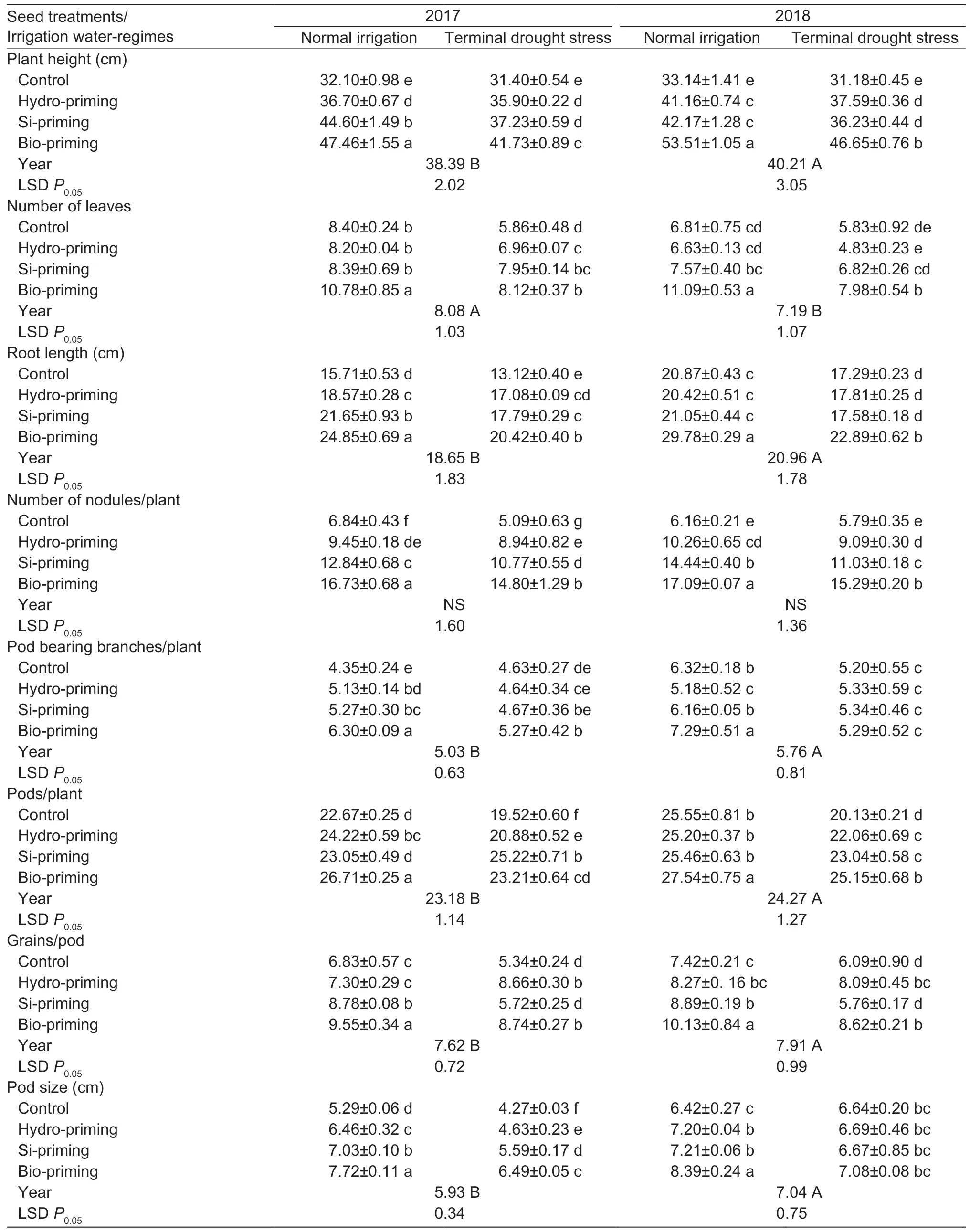
Table 3 Effect of seed priming (bio-,si-and hydro-priming) on the morphological attributes of mungbean plants under terminal drought stress
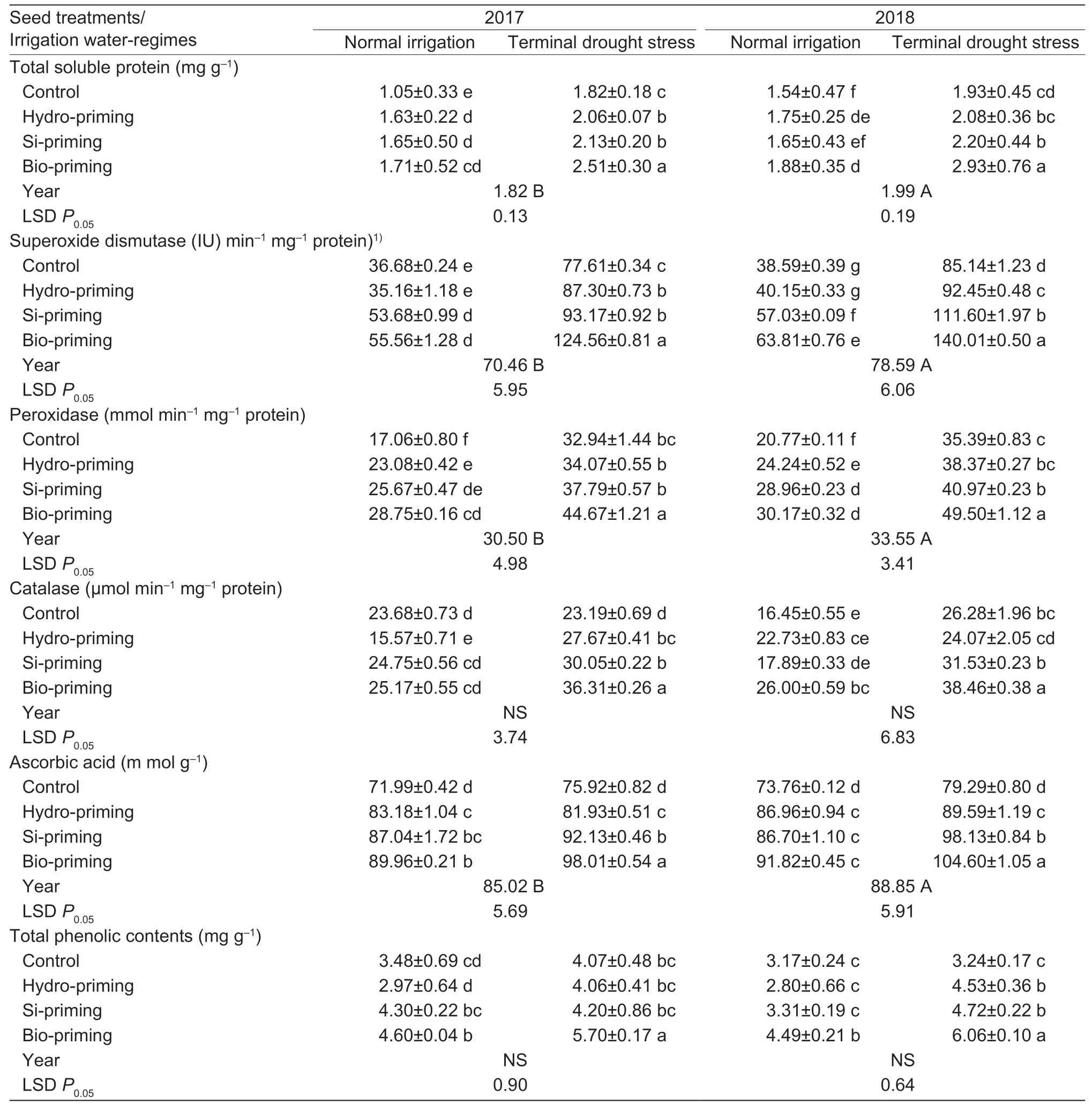
Table 4 Effect of seed priming (bio-,si-and hydro-priming) on antioxidant defense system of mungbean plants under terminal water stress
3.5.Economic analysis
The economic analysis presented that mungbean crop treated with various seed priming’s techniques under normal irrigations had more net income and BCR compared with imposed terminal drought stress during 2017 and 2018(Table 6). Among seed treatments,bio-priming remained superior with the maximum BCR and net income than Sipriming and hydro-priming in this regard.
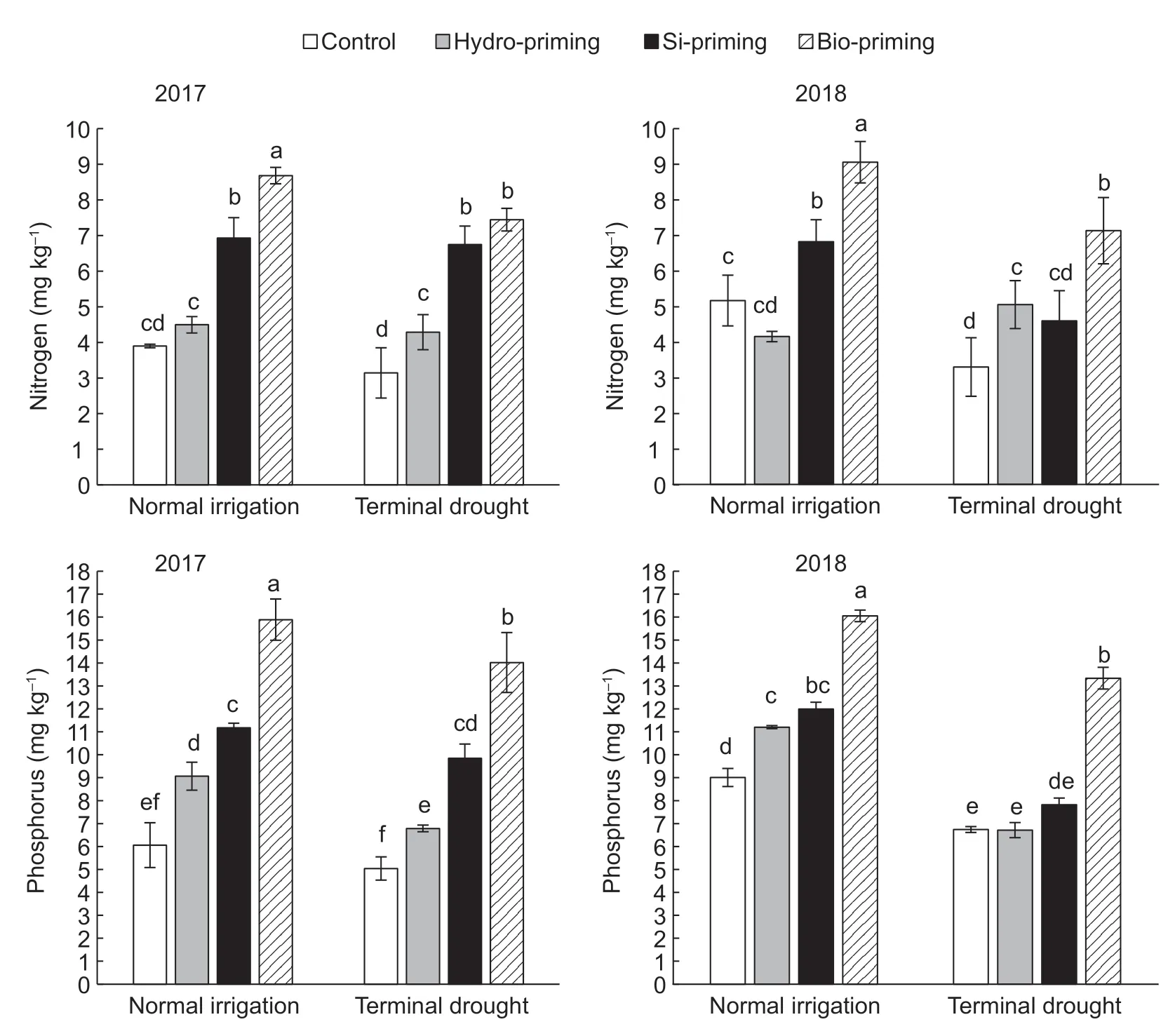
Fig.1 Effect of seed priming (bio-,si-and hydro-priming) on the available nitrogen and phosphorus (NP) in the experimental soil.Means sharing the different letters are significantly different from each other’s at LSD (P<0.05). Bars mean SE (n=3).
4.Discussion
Mungbean yield is the result of the shared effect of various attributes including plant height,pods bearing branches,pods per plant,seeds per pod,etc.,under a given set of crop husbandry conditions (Chaveset al.2003). In the present study,terminal drought stress hampered the yield due to a notable decrease in seeds per plant,biological yield,grain yield,etc.,in both years of experiments. Some earlier reports also revealed that mungbean is considered as a water-sensitive crop and its yield diminished under moisture stress conditions (Hassanet al.2017). Drought stress at any terminal reproductive growth stage may cause changes in plant morphology,physiology and consequently nutrient uptake processes. The most critical time for irrigation requirement is the flowering and early pod development of the crop. Shortened plant height associated with abridged leaves and pods formation due to reduced photosynthesis processes,accelerated leaf senescence,and sink limitation might be responsible for small seed size development and lesser 1 000-seed weight under terminal drought stress (Ranawakeet al.2011). Moreover,less grain yield is also attributed to the lesser pods bearing branches and seeds per pod under terminal drought stress may be due to inefficient partitioning of assimilates accumulation during the development of grains (Bourgaultet al.2010).A positive relation between biological yield and grain yield under normal irrigations resulted in higher productivity is thought to be due to the availability of favorable source-sink relations (Mahmood Set al.2016). Some earlier reports also highlighted that seed treated with bio-priming and Sipriming before sowing may lead to vigorous production of germination metabolites,better root system development,faster genetic process like RNA,DNA and protein synthesis,stimulate the seed biochemical processes for an earlier breakdown of seed dormancy (Ahmadet al.2011). Terminal drought stress produced a higher level of ethylene,which inhibited the plant’s root growth and nodulation. The treated bio-priming technique has the capability for lowering the ethylene production may be due to the presence of ACCdeaminase enzymes,which triggered better root growth and nodules formation in mungbean crops (Nazet al.2009). Curtailed grain yield under terminal drought stress after treatment with bio-priming technique appeared to be ameliorated by efficient mobilization and utilization of seed reserves for better plant morphological performance. Based on the author’s best review,this present study emphasized that all the improved attributes related to plant morphological growth and yield components under imposed terminal water stress were due to bio-priming technique (Sahran and Nehra 2011).
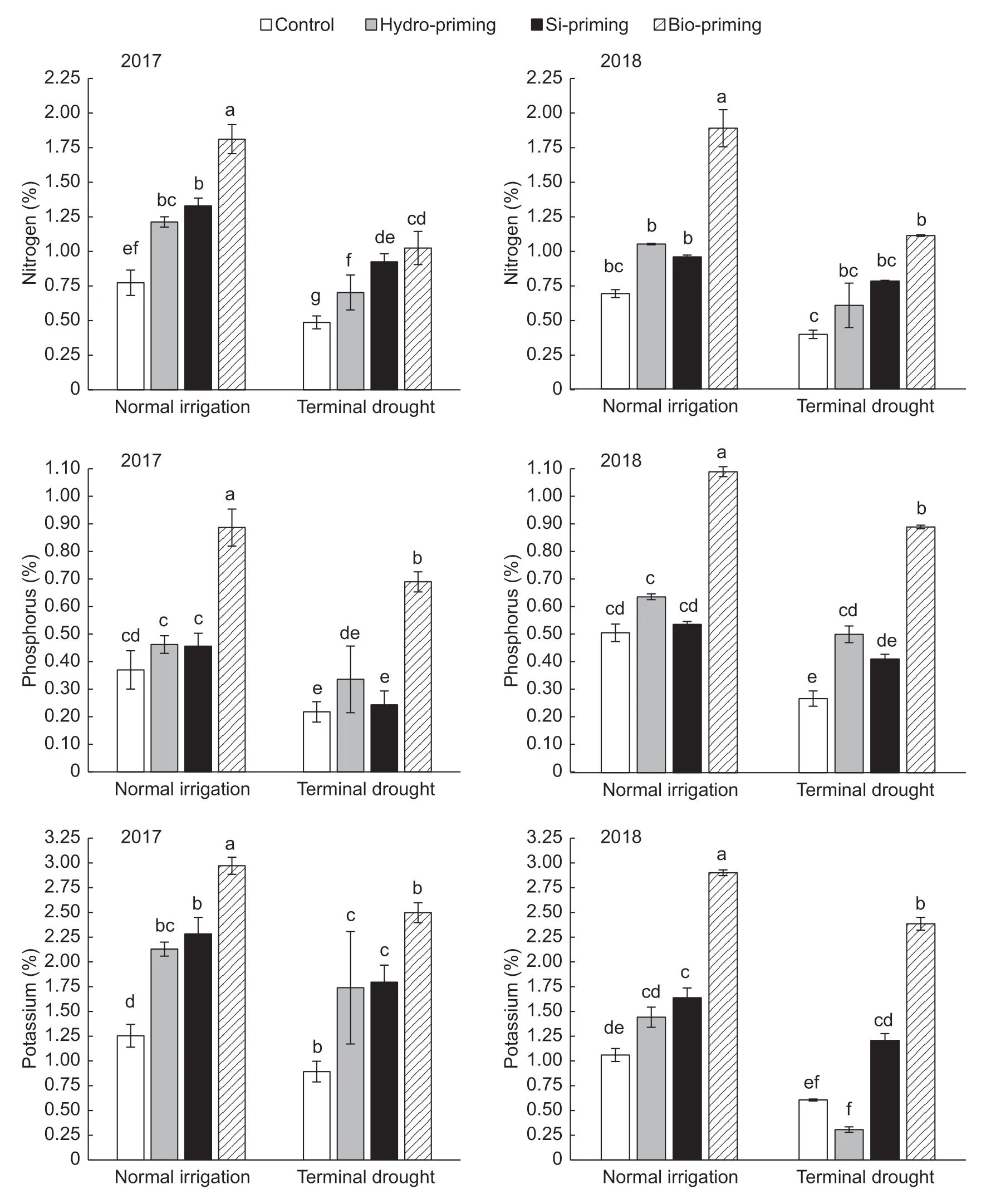
Fig.2 Effect of seed priming (bio-,si-and hydro-priming) on nitrogen,phosphorus and potassium (NPK) uptake in mungbean root.Means sharing the different letters are significantly different from each other at LSD (P<0.05). Bars mean SE (n=3).
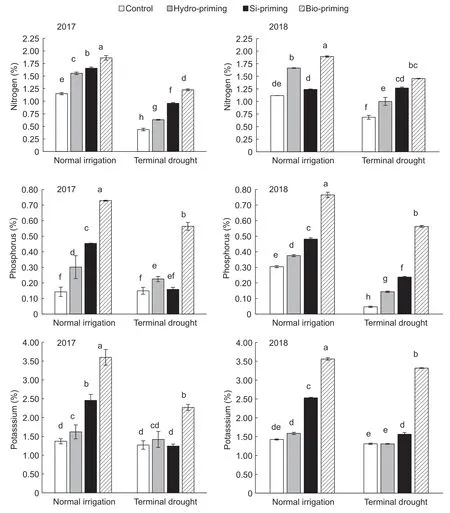
Fig.3 Effect of seed priming (bio-,si-and hydro-priming) on nitrogen,phosphorus and potassium (NPK) uptake in mungbean shoot. Means sharing the different letters are significantly different from each other at LSD (P<0.05). Bars mean SE (n=3).
Oxidative damaging impact at the cellular level under terminal drought stress disturbed the homeostasis level between ROS and quenching behavior of the antioxidant defense system in mungbean crop (Gill and Tuteja 2010).The potential plants have the ability to prevent the production of toxic or active ionic forms of oxygen-free radicles are seemed to be a significant adaptation to make tolerance against terminal drought stress conditions (Nawazet al.2016). In this adaptation,plant defended itself against oxidative damages through producing the enzymatic and non-enzymatic antioxidant defense system and inhibiting the release of ROS molecules. In this study,the increasing trend of antioxidant contents by using the various seed priming techniques under terminal drought stress conditions is one of the best sustainable agronomic strategies (Farooqet al.2009). Among the applied seed priming treatments,bio-priming technique performed prominently better in modulating the drought stress during the subjected terminal drought stress condition and triggered the enzymatic (TSP,SOD,POD,and CAT) antioxidant contents for balancing the redox status (Ahmedet al.2002). Moreover,the maximum release of non-enzymatic (AsA and TPC) antioxidant contents in the treated mungbean seeds with bio-priming under terminal water deficit condition enhanced the plant tolerance and ameliorated the photosynthetic assimilate production for better grain yield. The experiment revealed that bio-priming may have an important regulatory role in removing the excessive production of ROS molecules in terminal drought stress condition (Farooqet al.2014). Biopriming seed treatment play a crucial action in protecting the cellular oxidative damages may be due to having aminocyclopropane carboxylate (ACC-deaminase) enzyme.This enzyme (ACC-deaminase) has an ability to enhance the plant antioxidant defense system by mitigating the ethylene and ROS production for imposed terminal drought stress(Ahmadet al.2013).
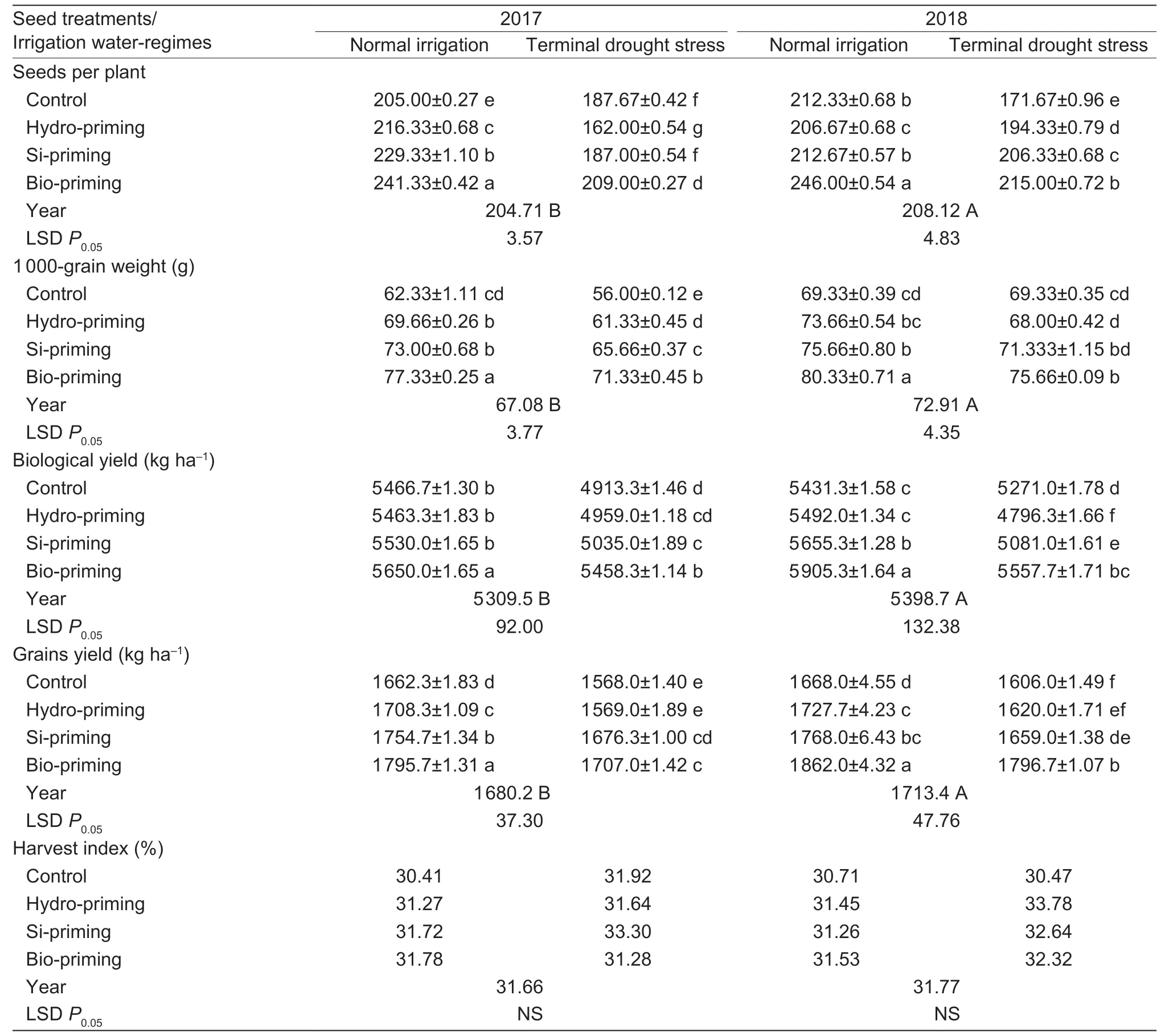
Table 5 Effect of seed priming (bio-,si-and hydro-priming) on the yield related components of mungbean plants under terminal drought stress

Table 6 Economic analysis of treated seed priming techniques in mung bean under terminal drought stress
Nonetheless,the bio-priming technique alleviate the damaging effects of terminal drought stress to some extent on mungbean grains yield may be due to the maximum availability of NP in the experimental soil for better healthy plant development at the early stage of growth (Karunakaranet al.2013). Moreover,the treated seeds with bio-priming and Si-priming help in improving the early synchronized potential emergence and seedling establishment may be due to efficient utilization of resources including’s NP contents in the soil during the entire growing season of the crop under normal irrigation and terminal drought stress condition (Kumar and Sharma 2009). On the other hand,bio-priming prominently enhance the NPK uptake in the roots of mungbean plants may be the reason for providing more assimilates for healthier pods and grain development.Drought tolerance at the terminal reproductive growth stage is the most important strategy for obtaining the economical yield. The presence of the maximum NPK uptake in mungbean shoots by bio-priming-treated plants becomes the reason that the development of vigorous reproductive organs might be due to effective photo-assimilate production and partitioning in a source-sink relationship (Rashidet al.2004). Nitrogen fixation in mungbean crop is sensitive to drought stress,especially at terminal reproductive growth stages. In this present study,the increasing grain productivity by bio-priming under terminal drought stress conditions might be due to increase in the number and shape of root hairs for nodule formation (structure and weight)(Harriset al.2005).
The economic analysis showed the commercial feasibility of any innovation or technique for farmer’s adaptation in terms of expenditure cost. The maximum net income and BCR by bio-priming with comparative low expenditure during the terminal drought stress proved the notable effective technique in mungbean production (De Costaet al.1999).Hence,bio-priming is important for small-scale resourcepoor farmers to adopt this cost-effective technique with few external inputs.
5.Conclusion
The present study demonstrated that bio-priming in mungbean crop is the most effective,sustainable and agronomic approach for enhancing morpho-physiological growth and productivity of mungbean under terminal drought stress. The bio-priming inducing enhancement in plant growth and drought tolerance are attributed to better antioxidant defense system,enhance nutrient uptake,and maintenance of osmotic balance under drought stress conditions. Seed primed after Bio-priming strategy can be practiced to determine the stress-tolerant proteins through SDS page for further future studies.
杂志排行
Journal of Integrative Agriculture的其它文章
- lnfectious disease-resistant pigs:Will they fly?
- Crop photosynthetic response to light quality and light intensity
- Alginate oligosaccharides preparation,biological activities and their application in livestock and poultry
- Genome-wide pedigree analysis of elite rice Shuhui 527 reveals key regions for breeding
- TaSnRK2.4 is a vital regulator in control of thousand-kernel weight and response to abiotic stress in wheat
- Development and characterization of new allohexaploid resistant to web blotch in peanut
